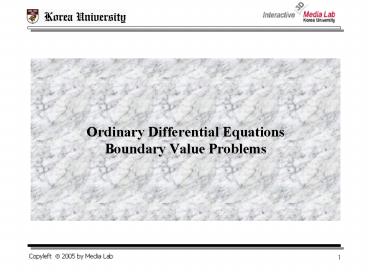Ordinary Differential Equations Boundary Value Problems - PowerPoint PPT Presentation
1 / 23
Title:
Ordinary Differential Equations Boundary Value Problems
Description:
Title: Author: Nicholas Park Last modified by: eyes_blues Created Date: 3/28/1999 2:55:44 AM Document presentation format – PowerPoint PPT presentation
Number of Views:116
Avg rating:3.0/5.0
Title: Ordinary Differential Equations Boundary Value Problems
1
Ordinary Differential EquationsBoundary Value
Problems
2
14.1 Shooting Method for Solving Linear BVPs
- We investigate the second-order, two-point
boundary-value problem of the form - with Dirichlet boundary conditions
- Or Neuman boundary conditions
- Or mixed boundary condition
3
14.1 Shooting Method for Solving Linear BVPs
- Simple Boundary Conditions
- The approach is to solve the two IVPs
- If the solution of the original
two-point BVP is given by - y(x) u(x) Av(x) is found from the
requirement that y(b) u(b) Av(b) yb -
?
4
14.3 Shooting Method for Solving Linear BVPs
- EX14.1
- convert to the pair of initial-value problems
5
14.1 Shooting Method for Solving Linear BVPs
- General Boundary Condition at x b
- The condition at xb involves a linear
combination of y(b) and y(b) - The approach is to solve the two IVPs
- If there is a unique
solution, given by
6
14.3 Shooting Method for Solving Linear BVPs
- General Boundary Condition at Both Ends of the
Interval - the approach is to solve two IVPs
- If , there is a
unique solution, given by
7
14.3 Shooting Method for Solving Linear BVPs
- Ex 14.4
- ?
- Ex 14.5
- ?
8
14.2 Shooting Method for Solving NonLinear BVPs
- Nonlinear Shooting Based on the Secant Method
- use an iterative process based on the secant
method presented in Chapter 2 - the initial slope t, begin with u(a) t(1)
0, error is m(1) Unless the absolute value of
m(1) is less than the tolerance, we continue by
solving eq.
9
14.2 Shooting Method for Solving NonLinear BVPs
- EX 14.6
- ? y 1/(x1)
10
14.2 Shooting Method for Solving NonLinear BVPs
- Nonlinear Shooting Using Newtons Method
begin by solving the initial-value problem
Check for convergence - if m lt tol, stop
- Otherwise, update t
11
14.2 Shooting Method for Solving NonLinear BVPs
- EX 14.8
12
14.3 Finite Difference Method for Solving Linear
BVPs
- Replace the derivatives in the differential
equation by finite-difference approximations
(discussed in Chapter 11). - We now consider the general linear two-point
boundary-value problem - with boundary conditions
- To solve this problem using finite-differences,
we divide the interval a, b into n
subintervals, so that h(b-a)/n. To approximate
the function y(x) at the points
we use the central
difference formulas from Chapter 11
13
Finite Difference Method for Solving Linear BVPs
- Substituting these expressions into the BVP and
writing as ____
as and as gives - Further algebraic simplification leads to a
tridiagonal system for the unknowns
viz. - where and
.
14
Finite Difference Method for Solving Linear BVPs
- Expanding this expression into the full system
gives
15
Example 14.9 A Finite-Difference Problem
- Use the finite-difference method to solve the
problem - with y(0)y(4)0 and n4 subintervals.
- Using the central difference formula for the
second derivative, we find that the differential
equation becomes the system. - For this example, h 1 ,i 1, y 0, and i
3, y 0. Substituting this values, we obtain
16
Example 14.9 A Finite-Difference Problem
- Combining like terms and simplifying gives
- Solving, we find that y_113/7, y_2 18/7, and
y_3 13/7. - We note for comparison that the exact solution
of this problem is
17
Example 14.9 A Finite-Difference Problem
18
Example 14.10 A Matlab Script for a Linear FDP.
- The Matlab script that follows solves the BVP.
function S_linear_FD aa 0 bb 3 n 300 p
2ones(1, n-1) q -2ones(1, n-1) r
zeros(1, n-1) ya 0.1 yb 0.1exp(3)cos(3)
h (bb-aa)/n h2 h/2 hh hh x
linspace(aah, bb, n) a zeros(1, n-1) b
a a(1n-2) 1 - p(1, 1n-2)h2 d -(2
hhq) b(2n-1) 1 p(1, 2n-1)h2 c(1)
hhr(1) - (1p(1)h2)ya c(2n-2)
hhr(2n-2) c(n-1) hhr(n-1) - (1 -
p(n-1)h2)yb y Thomas(a, d, b, c) xx aa
x yy ya y yb out xx' yy'
disp(out) plot(xx, yy), grid on, hold on plot(xx,
0.1exp(xx).cos(xx)) hold off
19
Example 14.10 A Matlab Script for a Linear FDP.
20
14.4 FDM for Solving Nonlinear BVPs
- We consider the nonlinear ODE-BVP of the form
- Assume that there are constants and
such that - Use a finite-difference grid with spacing
and let denote the result of
evaluating at using
for . - The ODE then becomes the system
- An explicit iteration scheme, analogous to the
SOR method - where and The process
will converge for
21
Example 14.12 Solving a Nonlinear BVP by Using FDM
- Consider again the nonlinear BVP
- We illustrate the use of the iterative
procedure just outlined by taking a grid with h
¼. The general form of the difference equation is
- where
22
Example 14.12 Solving a Nonlinear BVP by Using FDM
- Substituting the rightmost expression for f_i
into the equation for y_i, we obtain - The computed solution after 10 iterations
agrees very closely with the exact solution.
function S_nonlinear_FD ya 1 yb 2 a 0 b
1 max_it 10 n 4 w 0.1 ww
1/(2(1w)) h (b-a)/n y(1n-1) 1 for k
1max_it y(1) ww(ya2wy(1)y(2)(ya2-2y
ay(2)y(2)2)/(4y(1))) y(2)
ww(y(1)2wy(2)y(3)(y(1)2-2y(1)y(3)y(3)2)
/(4y(2))) y(3) ww(y(2)2wy(3)yb(y(2)
2-2y(2)ybyb2)/(4y(3))) end x a ah
a2h a3h b z ya y yb plot(x,
z), hold on, zz sqrt(3x1) plot(x, zz), hold
off
23
Example 14.12 Solving a Nonlinear BVP by Using FDM































